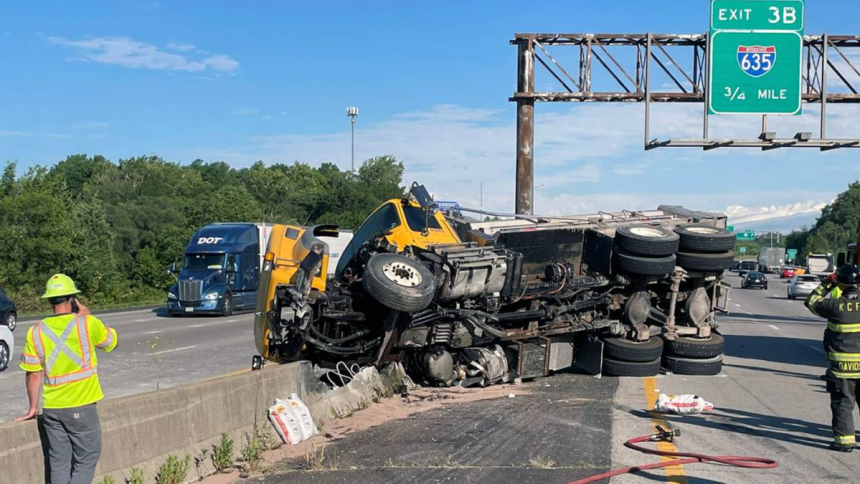Commercial truck accidents in Kansas City are not just traffic incidents but complex events often resulting from multiple contributing factors.
The dense traffic, intricate network of freeways, and significant commercial activity make this region a hotspot for such accidents. Understanding the various causes behind these accidents is crucial for developing strategies to prevent them and ensure the safety of all road users.
Analyzing these incidents involves looking at driver behavior, vehicle maintenance, road conditions, and regulatory compliance. For those affected by such accidents, the Miller & Hine truck accident law firm in Kansas City provides expert legal assistance, helping to navigate the aftermath of complex truck accidents.
In this article, we will delve into the various factors contributing to commercial truck accidents in the area, shedding light on how each element plays a role in road safety.
Driver Error
Driver error is a significant factor contributing to truck accidents in Kansas City, with mistakes ranging from misjudging stopping distances to distracted driving, often exacerbated by the use of mobile devices. The pressures of tight delivery schedules and insufficient training can lead drivers to adopt risky behaviors despite stringent road safety regulations. These issues highlight the need for better training programs focusing on the real-world challenges drivers face.
Fatigue significantly compounds the risk of driver error, as prolonged hours behind the wheel without sufficient breaks diminish a driver’s alertness and ability to react promptly. This state of impaired judgment and slowed reaction times increases the likelihood of critical mistakes that could lead to accidents.
To mitigate these risks, trucking companies in Kansas City must enforce regulated rest periods strictly and manage the workload of their drivers effectively. Ensuring drivers are well-rested and properly trained is essential for reducing driver-related errors and enhancing overall road safety.
Mechanical Failures
Mechanical failures in commercial trucks can lead to severe accidents, making regular maintenance and adopting advanced safety technologies crucial. Here’s how these factors play a key role in preventing mechanical issues that could lead to accidents:
- Brake Malfunctions and Tire Blowouts are among the most common mechanical failures that can cause accidents. Regular checks and timely maintenance of brakes and tires are essential to ensure they function correctly under all conditions.
- Regular Maintenance and Inspections: Despite the pressures of tight schedules and the temptation to cut costs, all trucks must undergo regular maintenance and detailed inspections to ensure they are in optimal working condition.
- Investment in Advanced Safety Features: Companies should continuously invest in the latest safety technologies for their fleets. Upgrades like stability control and automatic braking systems can greatly reduce the risk of accidents by compensating for potential mechanical failures.
- Keeping the Fleet Updated: Regular updates and upgrades to the fleet with the latest safety equipment prevent mechanical failures and ensure that the vehicles meet the highest safety standards. This proactive approach to fleet management significantly mitigates the risk associated with mechanical faults.
Weather Conditions
Kansas City’s weather can be highly unpredictable, varying from icy winters to wet, slippery roads during the rainy seasons. These varying conditions can significantly impair a truck’s handling and braking efficiency, elevating the risk of accidents. To combat this, drivers must receive training to manage these diverse weather scenarios, ensuring they can adjust their driving techniques to maintain safety.
Proactive preparation for adverse weather is crucial for minimizing risks on the road. This includes equipping trucks with appropriate tires for the conditions, adhering to recommended speed limits, and updating routes based on real-time weather changes.
Further, providing drivers with training in adaptive driving techniques enables them to handle their vehicles during poor weather conditions better, significantly reducing the likelihood of accidents.
Inadequate Road Infrastructure
In some areas of Kansas City, the road infrastructure is not ideally suited for heavy commercial traffic. Issues such as inadequate signage, poorly designed intersections, and lack of necessary highway maintenance can create hazardous conditions for truck drivers. Continuous monitoring and maintenance of road infrastructure by local authorities can help mitigate these risks.
Efforts to improve road layouts, including better lighting and clearer signage, can also significantly reduce truck accidents. Coordination between trucking companies and municipal authorities to address these issues can lead to safer roads for trucks and other vehicles.
Regulatory Non-Compliance
Regulatory non-compliance, including skipping mandatory breaks or overloading trucks, directly contributes to the risk of accidents. Strict enforcement of regulations by both companies and regulatory bodies is necessary to ensure road safety. Compliance with weight limits, rest periods, and other safety regulations must be monitored and enforced stringently.
Technology like Electronic Logging Devices (ELDs) can aid in enforcing compliance by providing accurate, tamper-proof records of drivers’ hours and vehicle loads. Regular audits and checks by authorities can further ensure adherence to these safety standards, reducing the risk of accidents due to non-compliance.
Traffic Congestion
Kansas City’s growing population and economic development have intensified traffic congestion, particularly in urban and industrial areas. This congestion heightens the likelihood of accidents due to the proximity of vehicles and adds to driver stress and fatigue, which are significant contributors to road mishaps. To address these issues, efficient route planning and enhanced traffic management are essential. These strategies help navigate congestion more effectively and can significantly mitigate associated risks.
The implementation of smart traffic systems and the provision of real-time traffic updates are critical measures that can help manage congestion efficiently. These systems guide drivers through less congested routes, helping to maintain a smooth flow of traffic. Furthermore, scheduling deliveries during off-peak hours can significantly reduce the number of large trucks on the roads during the busiest times of the day, thereby decreasing the potential for accidents.
Interaction with Other Road Users
The interaction between trucks and other road users, such as cars, motorcycles, and bicycles, often leads to accidents, particularly in high-traffic areas. The size and speed differences can create dangerous situations, especially when other drivers are unaware of a truck’s operational limitations, such as wide turning radii and longer stopping distances.
Education campaigns that inform the public about how to share the road with large trucks safely can be beneficial. Truck drivers also need to be aware of their surroundings and practice defensive driving techniques to anticipate the actions of smaller, more agile vehicles. This mutual understanding and respect can significantly decrease the likelihood of accidents.
Lynn Martelli is an editor at Readability. She received her MFA in Creative Writing from Antioch University and has worked as an editor for over 10 years. Lynn has edited a wide variety of books, including fiction, non-fiction, memoirs, and more. In her free time, Lynn enjoys reading, writing, and spending time with her family and friends.















